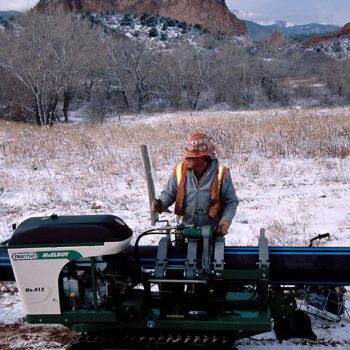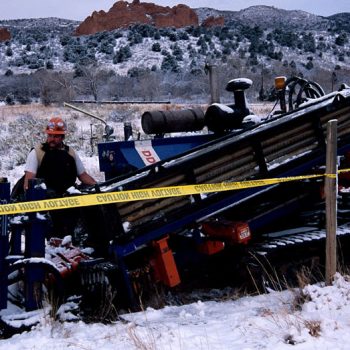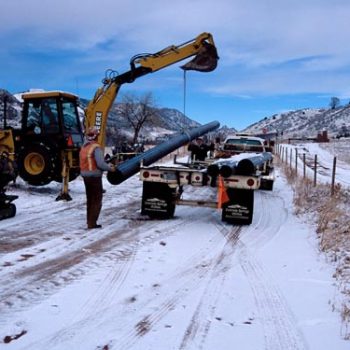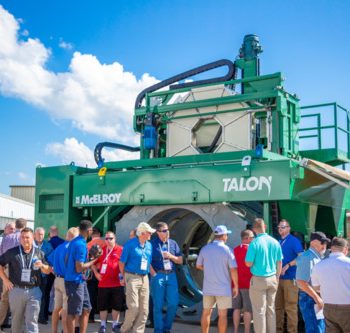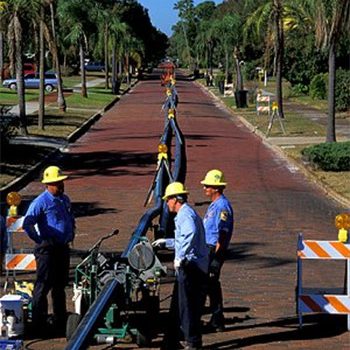Colorado Springs, Co. — Imagine standing below a geological rock formation that is so stunning it bears the name, Garden of the Gods. With that in mind, envision having to construct a water pipeline across this national landmark without disturbing its beauty or alarming the citizens who admire it on a daily basis. Caretakers are so particular about the delicate environment of the park that they cut the grass with a team of horses pulling a sickle.
Once upon a time officers of Colorado Springs Utilities (CSU) stood under these skyward jutting rocks and decided the only way to cross it, and keep everyone happy, would be with a horizontal bore.
While under tight regulations that limit the use of heavy equipment on the park, CSU is in the process of a 2,700-foot bore, installing 12″DIPS 3408 SDR-9 CP Performance series 4000 high-density polyethylene (HDPE). The line will provide potable water to a subdivision and provide increased fire flow protection to an expanding community.
Pipeline construction in many cases is an eyesore to communities and traditional open trench methods would be impossible for this project. While being good caretakers of their Garden of the Gods, the forward thinking city officials of CSU have joined together and are embracing new technologies for the water department that have been in use in the gas department for years. By doing this, CSU is also becoming a model of study for other municipalities who are in search of potable water applications that are long-term investments, environmentally safe, leak free and more affordable upon installation.
Polyethylene is what is going to happen to the waterworks business
“We’re trying to get more bang for our buck,” said Richard Bond, Construction Maintenance Section Leader for CSU. “For the year 2002 we’ve been able to slash $25 million off our utility budget by investing in equipment that will satisfy the needs of all three of the utilities, instead of each utility trying to buy their own equipment separately.”
Perhaps the exchanging of ideas and technologies between the gas and water departments has been the biggest advantage. The water department has borrowed horizontal boring techniques from the gas department and has saved thousands in asphalt repair expenditures alone.
Polyethylene pipe (PE) is the chief element that makes CSU and this project a pioneering venture. “The CSU gas department has been using PE since 1967 and had the know-how to bring this material to the water department,” said Pal Brown, Construction Supervisor overseeing the directional drilling crew on site. The Municipality has performed four water jobs using PE and is excited about the savings that have amassed due to the ease of installation. The long-term savings, due to no leaks, is a figure that could be staggering.
According to the U.S. Environmental Protection Agency, more than $138 billion needs to be spent on America’s water infrastructure through the year 2014 just to make it comply with current regulations. More than half this amount is needed for new distribution systems. Since PE does not rust, corrode or leak at the joints, many experts in the water business are promoting PE for the necessary improvements to the nations infrastructure problems.
“Polyethylene is what is going to happen to the waterworks business,” said Don Cole, Executive Vice President of Mountain States Pipe & Supply. “Of all the piping that is currently available in the lower pressure classes, HDPE has the most going for it. No cathodic protection is required, you can do most of the assembly out of the ditch, no thrust blocks or joint restraints are required, and its totally leak free. This material has found a home in water works”.
Along with supplying the pipe and fusion equipment for the project, Mountain States has also offered their consulting expertise to CSU for the past four PE jobs. Jack Madore is HDPE Product Manager for Mountain States and has seventeen years experience with PE pipeline construction and design.
“What makes this project unique is that we are using HDPE as it was designed to be used,” said Madore. “Most of the time, PE is just used where there is a high chance for failure of conventional materials, like a river bore or highway crossing. This is because PE is tough and flexible and with butt-fused joints, there is little chance of separation upon pull back when boring. HDPE has piggy backed its way into the municipal market on the back of directional drilling.”
“When CSU brought us in, there experience with conventional materials told them to bolt straight lengths in between mechanical fittings,” continued Madore. “After explaining that we could fuse everything together and eliminate half the fittings, all the joint restrains, thrust blocking and possible leak paths, they were now seeing a much more cost effective and long term leak free system. The logic behind it all is simple. If you can put it together and then take it apart mechanically, sooner or later it will leak. With fusion you are leak free as long as the material remains in service.”
For this project, reducing tees instead of swivel tees for the hydrant extensions were used as well as fusion fittings wherever possible. The only mechanical fittings that were used were at the valve connections. “What makes this job shine is that they are taking advantage of all of the benefits of PE and using it in the entire system to make it a fool-proof system,” said Madore.
For the fire hydrant selection, the city used a Mueller AquaGrip PE 12 x 6 reducing-tee. It was fused inline, then a valve was installed between the main and the fire hydrant using a Mueller AquaGrip fitting, which is a stab-compression style fitting that attaches to the bottom of the fire hydrant with out the use of internal stiffeners.
The biggest advantage of PE besides its long life expectancy is its heat-fused joints that make the pipe a single homogeneous pipeline. Joints in traditional piping materials are the biggest source of leakage. They are also the pathway for contaminates to enter the pipe system. Since this pipeline will only have gasketed joints where it transitions to other piping systems, the chance for leaks or infiltration is practically eliminated. In fact, the 2,700-foot bore alone has eliminated 135 joints when compared to traditional piping materials using 20-foot sections of pipe.
CSU used McElroy Manufacturing’s TracStar 412 fusion machine to join the pipe together. The TracStar is mounted on a mobile track system, which makes it an all-terrain machine. It is powered by a diesel engine and was used to pull the pipe out on the location with little disturbance to the terrain. Pal Brown CSU construction supervisor was in charge of all the fusion and was impressed with how the machine was able to transition between out of ditch and in ditch fusion. “Pull one pin and add the extension hoses and we were in business,” said Brown.
The bores were completed with a great amount of difficulty as a lot of rocks were encountered. An American Augers Model DD4 was used, “which is quite the little workhorse,” said Brown. It was needed on this job because more rocks than solid soil were encountered.
PE has been the standard pipe for the gas industry in the U.S. for about thirty years and is finally making a foothold in the water market. It has a proven record of being a no-leak system and municipalities such as CSU are helping others to understand its characteristics and how they translate into cost and construction advantages over other materials.
